In the dynamic and competitive world of transportation, a robust online presence is no longer optional—it’s essential. Your website is often the first impression you make on potential clients, and it needs to be more than just visually appealing. It needs to be a powerful tool that generates leads, streamlines operations, and builds trust. This comprehensive guide will explore every facet of website design for transportation companies, from understanding your audience to implementing advanced features that give you a competitive edge. Get ready to accelerate your business growth with a website that truly delivers.
Quick Summary:
- Understand your audience for effective design.
- Include key features like tracking and quotes.
- Use high-quality visuals and mobile-first design.
- Optimize for search engines to attract visitors.
Table of Contents
- 1. Understanding Your Target Audience: The Key to Effective Transportation Website Design
- 1.1. Identifying Your Niche: What Kind of Transportation Company Are You?
- 1.2. Creating User Personas: Putting a Face to Your Audience
- 1.3. Understanding User Intent: What Are They Looking For?
- 2. Essential Website Features for Transportation Companies
- 2.1. Clear and Concise Information: Making it Easy to Understand Your Services
- 2.2. Online Quote Request Form: Converting Visitors into Leads
- 2.3. Real-Time Tracking System: Enhancing Transparency and Customer Satisfaction
- 2.4. Online Booking and Scheduling: Streamlining Operations and Improving Efficiency
- 2.5. Driver Application Portal: Attracting and Retaining Talent
- 2.6. Blog and News Section: Establishing Thought Leadership and Enhancing SEO
- 2.7. Testimonials and Case Studies: Building Trust and Credibility
- 2.8. Multilingual Support: Reaching a Wider Audience
- 3. The Power of Visuals: Creating an Engaging and Memorable Website
- 3.1. High-Quality Images and Videos: Showcasing Your Fleet and Services
- 3.2. Consistent Branding: Creating a Recognizable Identity
- 3.3. Infographics and Data Visualization: Simplifying Complex Information
- 3.4. Mobile-First Design: Ensuring Accessibility on All Devices
- 4. Search Engine Optimization (SEO) for Transportation Websites: Driving Organic Traffic
- 4.1. Keyword Research: Identifying Relevant Search Terms
- 4.2. On-Page Optimization: Optimizing Website Content and Structure
- 4.3. Off-Page Optimization: Building Authority and Backlinks
- 4.4. Technical SEO: Ensuring Website Crawlability and Indexability
- 5. Measuring and Analyzing Website Performance: Data-Driven Optimization
- 5.1. Key Performance Indicators (KPIs): Tracking Relevant Metrics
- 5.2. Analytics Tools: Gathering and Analyzing Data
- 5.3. Data-Driven Optimization: Making Informed Decisions
- 6. Qrolic Technologies: Your Partner in Transportation Website Design and Logistics Web Development
- 6.1. Our Expertise:
- 6.2. Our Approach:
- 6.3. Why Choose Qrolic Technologies?
- 7. Future Trends in Transportation Website Design: Staying Ahead of the Curve
- 7.1. Artificial Intelligence (AI) and Chatbots: Providing Instant Customer Support
- 7.2. Blockchain Technology: Enhancing Transparency and Security
- 7.3. Augmented Reality (AR) and Virtual Reality (VR): Enhancing User Experience
- 7.4. Voice Search Optimization: Catering to Voice-Activated Devices
1. Understanding Your Target Audience: The Key to Effective Transportation Website Design
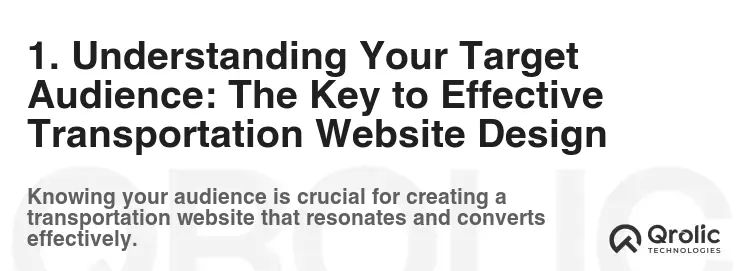
Before diving into design specifics, it’s crucial to identify and understand your target audience. Different transportation companies cater to different needs, and your website should reflect this.
1.1. Identifying Your Niche: What Kind of Transportation Company Are You?
- Trucking Companies: Focus on freight brokers, shippers, and potential drivers.
- Logistics Companies: Target businesses needing supply chain solutions, warehousing, and distribution services.
- Passenger Transportation (e.g., Buses, Taxis, Limousines): Aim at individuals, groups, and event planners seeking reliable transportation.
- Specialized Transportation (e.g., Hazardous Materials, Oversized Loads): Attract businesses with specific and complex transportation requirements.
- Moving Companies: Target individuals and families relocating their homes or businesses.
1.2. Creating User Personas: Putting a Face to Your Audience
Develop detailed user personas representing your ideal clients. Consider their:
- Demographics: Age, location, industry, company size.
- Needs & Goals: What problems are they trying to solve? What are their objectives?
- Pain Points: What are their frustrations with current transportation solutions?
- Technical Proficiency: How comfortable are they using technology? What devices do they use?
- Decision-Making Process: Who are the key influencers in their purchasing decisions?
Example:
- Persona: Sarah, a logistics manager at a manufacturing company.
- Demographics: 35 years old, located in Chicago, IL, manages logistics for a company with 100 employees.
- Needs & Goals: Needs a reliable transportation partner to deliver goods on time and within budget. Wants a transparent tracking system and proactive communication.
- Pain Points: Frustrated with late deliveries, lack of communication, and hidden fees from current providers.
- Technical Proficiency: Comfortable using online platforms and mobile apps.
- Decision-Making Process: Researches transportation providers online, reads reviews, and requests quotes from multiple companies.
1.3. Understanding User Intent: What Are They Looking For?
Analyze the keywords your target audience uses when searching for transportation services. This will inform your website’s content and SEO strategy.
- Informational Intent: “How to ship oversized cargo,” “Logistics solutions for small businesses.”
- Navigational Intent: “[Your Company Name] contact,” “[Your Company Name] tracking.”
- Transactional Intent: “Get a freight quote,” “Book a taxi online,” “Hire a moving company.”
By understanding your target audience and their intent, you can create a website that caters to their specific needs and provides a seamless user experience.
2. Essential Website Features for Transportation Companies
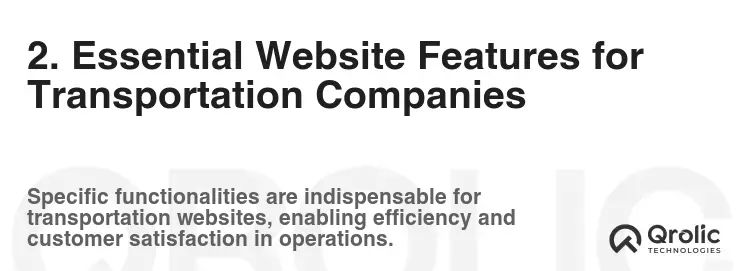
A successful transportation website goes beyond aesthetics. It needs to offer functionality that streamlines processes, enhances communication, and builds trust.
2.1. Clear and Concise Information: Making it Easy to Understand Your Services
- Service Descriptions: Clearly outline the transportation services you offer, highlighting key benefits and differentiators. Use concise language and avoid jargon.
- Coverage Area: Specify the geographic areas you serve. Use a map or list of locations for clarity.
- Industries Served: Showcase the industries you specialize in, demonstrating your expertise and experience.
- Equipment & Fleet: Display the types of vehicles and equipment you use, emphasizing their capabilities and safety features.
2.2. Online Quote Request Form: Converting Visitors into Leads
- Customizable Fields: Allow users to specify their transportation needs, such as origin, destination, dimensions, weight, and special requirements.
- Real-Time Quotes (if possible): Provide instant price estimates for standard services to encourage immediate action.
- Contact Information: Include clear contact information for follow-up and personalized service.
- Mobile Optimization: Ensure the form is easily accessible and usable on mobile devices.
2.3. Real-Time Tracking System: Enhancing Transparency and Customer Satisfaction
- User-Friendly Interface: Design an intuitive tracking system that allows customers to easily monitor the status of their shipments or vehicles.
- Detailed Information: Provide real-time updates on location, estimated time of arrival, and any delays or issues.
- Notifications: Offer email or SMS notifications for key milestones, such as pickup, delivery, and any changes in status.
- Integration with Existing Systems: Integrate the tracking system with your internal logistics management software for seamless data flow.
2.4. Online Booking and Scheduling: Streamlining Operations and Improving Efficiency
- Availability Calendar: Allow customers to view your availability and schedule transportation services online.
- Secure Payment Gateway: Integrate a secure payment gateway to process online payments and reduce administrative overhead.
- Automated Confirmations: Send automated email confirmations with booking details and instructions.
- Integration with Dispatch Systems: Connect the online booking system with your dispatch software for efficient scheduling and routing.
2.5. Driver Application Portal: Attracting and Retaining Talent
- Online Application Form: Simplify the application process by providing an online form for drivers to submit their information.
- Requirements and Qualifications: Clearly outline the qualifications and requirements for driver positions.
- Company Benefits: Highlight the benefits of working for your company, such as competitive pay, health insurance, and retirement plans.
- Mobile-Friendly Design: Ensure the application portal is accessible and usable on mobile devices.
2.6. Blog and News Section: Establishing Thought Leadership and Enhancing SEO
- Informative Content: Publish articles, blog posts, and news updates related to the transportation industry, providing valuable insights and information for your audience.
- Keyword Optimization: Optimize your content for relevant keywords to improve search engine rankings.
- Industry Trends: Share your insights on industry trends, regulations, and best practices.
- Company News: Announce company news, such as new services, partnerships, and awards.
2.7. Testimonials and Case Studies: Building Trust and Credibility
- Authentic Testimonials: Feature testimonials from satisfied customers, showcasing their positive experiences with your services.
- Detailed Case Studies: Develop detailed case studies that highlight how you have helped clients solve their transportation challenges.
- Visual Evidence: Include photos or videos of successful projects to further build trust and credibility.
- Prominent Placement: Display testimonials and case studies prominently on your website.
2.8. Multilingual Support: Reaching a Wider Audience
- Language Options: Offer your website in multiple languages to cater to a diverse customer base.
- Accurate Translations: Ensure accurate and professional translations of all website content.
- Cultural Sensitivity: Consider cultural differences when designing and developing your website.
- SEO Optimization: Optimize your website for search engines in each language.
By incorporating these essential features, your transportation website can become a valuable tool for generating leads, streamlining operations, and building strong customer relationships.
3. The Power of Visuals: Creating an Engaging and Memorable Website

Visual elements play a critical role in capturing attention and conveying your brand message. A well-designed website should use visuals strategically to enhance the user experience.
3.1. High-Quality Images and Videos: Showcasing Your Fleet and Services
- Professional Photography: Use professional-quality photos of your vehicles, equipment, and team members.
- Action Shots: Capture photos and videos of your services in action, showcasing your capabilities and expertise.
- Aerial Footage: Consider using drone footage to capture stunning aerial views of your facilities and operations.
- Video Testimonials: Feature video testimonials from satisfied customers to add a personal touch.
3.2. Consistent Branding: Creating a Recognizable Identity
- Logo and Color Palette: Use your company logo and color palette consistently throughout the website.
- Typography: Choose fonts that are easy to read and align with your brand identity.
- Imagery Style: Maintain a consistent style for all images and videos, reflecting your brand’s personality.
- Brand Voice: Use a consistent tone and voice in all written content, reflecting your brand’s values.
3.3. Infographics and Data Visualization: Simplifying Complex Information
- Data Charts: Use charts and graphs to visualize data related to your performance, such as on-time delivery rates and customer satisfaction scores.
- Process Flowcharts: Illustrate your transportation processes with flowcharts to demonstrate your efficiency and transparency.
- Geographic Maps: Use maps to showcase your coverage area and the routes you serve.
- Interactive Elements: Incorporate interactive elements to engage users and make data more accessible.
3.4. Mobile-First Design: Ensuring Accessibility on All Devices
- Responsive Layout: Design your website to adapt seamlessly to different screen sizes and devices.
- Touch-Friendly Navigation: Ensure the navigation is easy to use on touchscreens.
- Fast Loading Times: Optimize your website for fast loading times on mobile devices.
- Mobile-Specific Features: Consider adding mobile-specific features, such as click-to-call buttons and location-based services.
By incorporating high-quality visuals, consistent branding, and a mobile-first design, you can create a website that is visually appealing, engaging, and accessible to a wide audience.
4. Search Engine Optimization (SEO) for Transportation Websites: Driving Organic Traffic
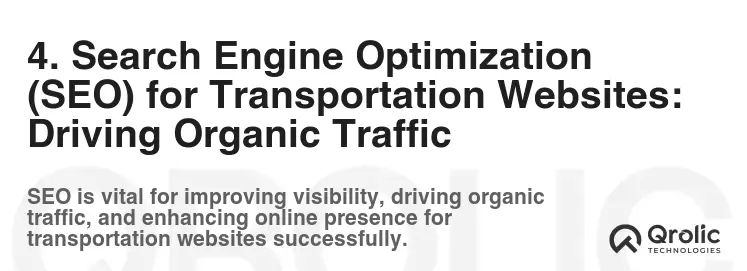
SEO is crucial for attracting potential clients to your website. By optimizing your website for search engines, you can improve your rankings and increase organic traffic.
4.1. Keyword Research: Identifying Relevant Search Terms
- Identify Core Keywords: Determine the primary keywords related to your transportation services, such as “freight transportation,” “logistics solutions,” and “moving companies.”
- Long-Tail Keywords: Research long-tail keywords that are more specific and targeted, such as “affordable freight shipping from Chicago to Los Angeles” or “reliable moving company for small apartments.”
- Competitor Analysis: Analyze your competitors’ websites to identify the keywords they are targeting.
- Use Keyword Research Tools: Utilize tools like Google Keyword Planner, SEMrush, and Ahrefs to discover relevant keywords and analyze their search volume and competition.
4.2. On-Page Optimization: Optimizing Website Content and Structure
- Title Tags: Optimize your title tags with relevant keywords, ensuring they accurately reflect the content of each page.
- Meta Descriptions: Write compelling meta descriptions that entice users to click on your website in search results.
- Header Tags (H1-H6): Use header tags to structure your content and highlight important keywords.
- Content Optimization: Incorporate relevant keywords naturally throughout your website content, avoiding keyword stuffing.
- Image Optimization: Optimize your images with descriptive alt tags and file names, using relevant keywords.
- Internal Linking: Link to relevant pages within your website to improve navigation and SEO.
- URL Structure: Use descriptive and keyword-rich URLs for each page.
4.3. Off-Page Optimization: Building Authority and Backlinks
- Link Building: Acquire backlinks from reputable websites in the transportation industry, such as industry directories, blogs, and news sites.
- Social Media Marketing: Promote your website and content on social media platforms to increase visibility and engagement.
- Online Directories: List your company in relevant online directories, such as Yelp, Google My Business, and industry-specific directories.
- Guest Blogging: Write guest posts for other websites in the transportation industry, including links back to your website.
- Public Relations: Issue press releases about company news and achievements to generate media coverage and backlinks.
4.4. Technical SEO: Ensuring Website Crawlability and Indexability
- Website Speed: Optimize your website for fast loading times to improve user experience and SEO.
- Mobile-Friendliness: Ensure your website is mobile-friendly to cater to the growing number of mobile users.
- Site Structure: Create a clear and logical site structure to make it easy for search engines to crawl and index your website.
- XML Sitemap: Submit an XML sitemap to Google Search Console to help search engines discover and index your website’s pages.
- Robots.txt: Use a robots.txt file to control which pages search engines can crawl and index.
- SSL Certificate: Install an SSL certificate to secure your website and improve its search engine ranking.
By implementing a comprehensive SEO strategy, you can significantly improve your website’s visibility in search engine results pages and attract more organic traffic.
5. Measuring and Analyzing Website Performance: Data-Driven Optimization
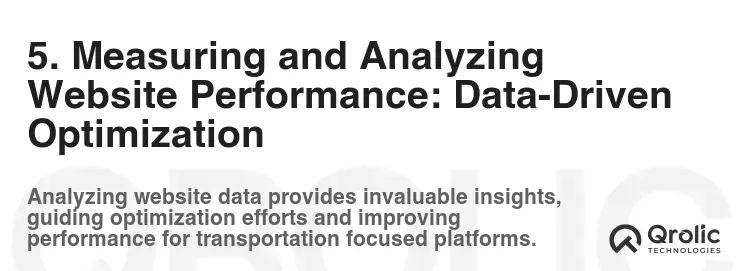
It’s essential to track and analyze your website’s performance to identify areas for improvement and optimize your marketing efforts.
5.1. Key Performance Indicators (KPIs): Tracking Relevant Metrics
- Website Traffic: Monitor the number of visitors to your website, including unique visitors, page views, and bounce rate.
- Traffic Sources: Analyze the sources of your website traffic, such as organic search, paid advertising, social media, and referral links.
- Conversion Rate: Track the percentage of website visitors who complete a desired action, such as submitting a quote request or booking a service.
- Lead Generation: Measure the number of leads generated through your website, including contact form submissions, phone calls, and email inquiries.
- Customer Acquisition Cost: Calculate the cost of acquiring a new customer through your website.
- Return on Investment (ROI): Measure the return on investment for your website and marketing efforts.
5.2. Analytics Tools: Gathering and Analyzing Data
- Google Analytics: Use Google Analytics to track website traffic, user behavior, and conversions.
- Google Search Console: Use Google Search Console to monitor your website’s performance in Google search results and identify any technical issues.
- Heatmaps: Use heatmaps to visualize user behavior on your website, such as where they click, scroll, and spend their time.
- A/B Testing Tools: Use A/B testing tools to test different versions of your website and identify which performs best.
- Customer Relationship Management (CRM) Systems: Integrate your website with a CRM system to track leads, manage customer interactions, and measure sales performance.
5.3. Data-Driven Optimization: Making Informed Decisions
- Identify Areas for Improvement: Analyze your website’s performance data to identify areas where you can improve user experience, SEO, and conversion rates.
- Implement Changes: Make changes to your website based on your analysis, such as optimizing content, improving navigation, and adding new features.
- Test and Measure: Test the impact of your changes and measure their effectiveness using analytics tools.
- Continuously Optimize: Continuously monitor your website’s performance and make ongoing optimizations to improve its effectiveness.
By tracking and analyzing your website’s performance, you can make data-driven decisions that improve user experience, increase conversions, and drive business growth.
6. Qrolic Technologies: Your Partner in Transportation Website Design and Logistics Web Development
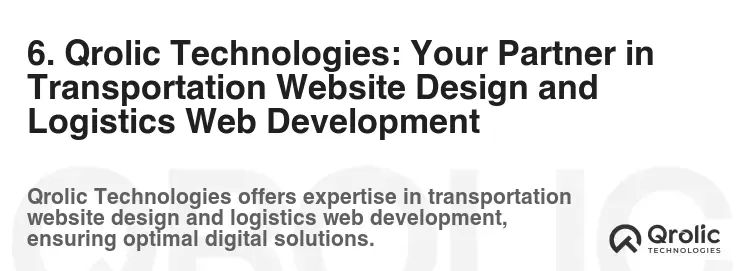
Qrolic Technologies (https://qrolic.com/) is a leading web development company specializing in creating custom website solutions for transportation and logistics companies. We understand the unique challenges and opportunities in the industry and offer a comprehensive range of services to help you succeed online.
6.1. Our Expertise:
- Transportation Website Design: We create visually appealing and user-friendly websites that showcase your services and attract potential clients.
- Logistics Web Development: We develop custom logistics web applications that streamline your operations, improve efficiency, and enhance customer satisfaction.
- E-Commerce Solutions for Transportation: We build e-commerce platforms that allow you to sell transportation services online, such as freight shipping and passenger transportation.
- Mobile App Development: We develop mobile apps for iOS and Android devices that allow your customers to track shipments, book services, and manage their accounts on the go.
- SEO and Digital Marketing: We provide SEO and digital marketing services to help you improve your website’s visibility in search engine results pages and attract more organic traffic.
6.2. Our Approach:
- Custom Solutions: We develop custom website solutions that are tailored to your specific needs and requirements.
- User-Centric Design: We prioritize user experience and create websites that are easy to use and navigate.
- Mobile-First Approach: We design websites that are mobile-friendly and accessible on all devices.
- Data-Driven Optimization: We use data analytics to track website performance and make ongoing optimizations.
- Ongoing Support: We provide ongoing support and maintenance to ensure your website remains up-to-date and secure.
6.3. Why Choose Qrolic Technologies?
- Industry Expertise: We have extensive experience working with transportation and logistics companies.
- Proven Track Record: We have a proven track record of delivering successful website solutions.
- Dedicated Team: We have a dedicated team of experienced web developers, designers, and marketers.
- Competitive Pricing: We offer competitive pricing and flexible payment options.
- Customer Satisfaction: We are committed to providing excellent customer service and ensuring your satisfaction.
Partner with Qrolic Technologies to create a powerful online presence that drives your transportation business forward. Contact us today for a free consultation.
7. Future Trends in Transportation Website Design: Staying Ahead of the Curve
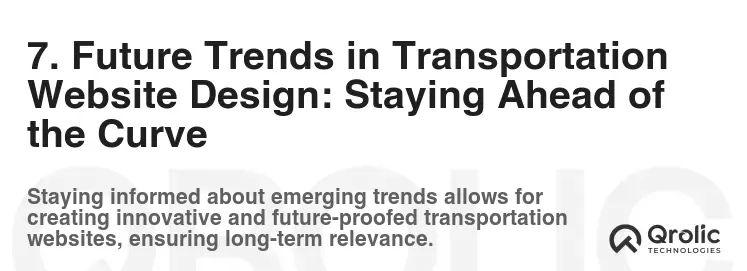
The transportation industry is constantly evolving, and your website needs to adapt to stay ahead of the curve. Here are some future trends to consider:
7.1. Artificial Intelligence (AI) and Chatbots: Providing Instant Customer Support
- AI-Powered Chatbots: Implement AI-powered chatbots to provide instant customer support, answer frequently asked questions, and guide users through the booking process.
- Personalized Recommendations: Use AI to provide personalized recommendations for transportation services based on user preferences and past behavior.
- Predictive Analytics: Use AI to predict potential delays and disruptions in transportation schedules, allowing you to proactively communicate with customers.
7.2. Blockchain Technology: Enhancing Transparency and Security
- Secure Transactions: Use blockchain technology to secure online payments and prevent fraud.
- Supply Chain Tracking: Implement blockchain-based supply chain tracking systems to provide real-time visibility and transparency.
- Smart Contracts: Use smart contracts to automate agreements between transportation providers and customers, ensuring fair and transparent terms.
7.3. Augmented Reality (AR) and Virtual Reality (VR): Enhancing User Experience
- Virtual Tours: Offer virtual tours of your facilities and equipment to showcase your capabilities and build trust.
- AR-Enhanced Tracking: Use AR to overlay real-time tracking information onto a user’s view of their surroundings, providing a more immersive experience.
- Interactive Training: Use VR to provide interactive training simulations for drivers and logistics personnel.
7.4. Voice Search Optimization: Catering to Voice-Activated Devices
- Optimize for Voice Keywords: Optimize your website content for voice search queries, using natural language and conversational phrases.
- Schema Markup: Implement schema markup to provide structured data to search engines, making it easier for them to understand your website’s content and answer voice search queries.
- Voice-Enabled Navigation: Add voice-enabled navigation to your website to allow users to easily find information using voice commands.
By embracing these future trends, you can create a transportation website that is innovative, engaging, and provides a competitive edge in the rapidly evolving industry.
In conclusion, a well-designed website is a critical asset for transportation companies seeking to thrive in today’s digital landscape. By understanding your target audience, implementing essential features, leveraging visuals, optimizing for search engines, and embracing future trends, you can create a website that drives business growth, enhances customer satisfaction, and establishes you as a leader in the transportation industry. Remember to partner with experienced professionals like Qrolic Technologies to ensure your website is built to the highest standards and delivers the results you need. Now, go forth and drive your business forward with a website that truly delivers!






